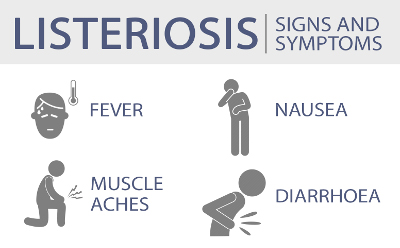News & Events
Let’s not take listeriosis lightly

Listeriosis is a disease caused by the bacterium Listeria monocytogenes. In most cases, people become infected by eating foods contaminated with this bacterium. However, a study conducted in South Africa has reported that municipal drinking water could also be a source of infection.
Between 5 December 2017 and 13 January 2018, the media reported 748 laboratory-confirmed cases of listeriosis in South Africa, of which 67 have been fatal. This information has been confirmed by the National Institute of Communicable Diseases and the Minister of Health, Dr Motsoaledi. Dr Prudence N Kayoka-Kabongo, Senior Lecturer in Unisa’s Department of Agriculture and Animal Health, shares her insight and expertise.
The World Health Organisation has said that this is the largest world outbreak since the outbreak in the United States in 2011, during which 147 cases were reported. South Africa has declared the disease notifiable, which means that every case must be reported to the Department of Health. Two-thirds of the cases have occurred in Gauteng, with the Western Cape and Kwazulu-Natal being the provinces in which the next highest number of cases have been reported. Although a chicken abattoir has been suspected as possible source of infection, up until now it has been difficult to trace accurately the source of infection, as the bacterium occurs throughout the environment, and the incubation period can be as long as two months. The severity of this outbreak is causing concern, and the Unisa community therefore needs to be informed about this preventable and treatable disease, and share the information with family and friends.
Listeriosis is a disease caused by the bacterium Listeria monocytogenes. In most cases, people become infected by eating foods contaminated with this bacterium. However, a study conducted in South Africa has reported that municipal drinking water could also be a source of infection.
Who can get listeriosis?
Anyone can get listeriosis. However, people at high risk include those whose immune system has been compromised or weakened. This includes pregnant women, babies, children, the elderly, and people with cancer, HIV/AIDS, diabetes, chronic kidney disease, liver disease, and alcoholism.
Where do we find the bacterium that causes listeriosis?
Listeria monocytogenes occurs widely in agricultural, aquacultural, and food processing environments. This bacterium is found in soil, where it survives longer in moist soil. It can be found in water, vegetation, fruits, foods, and premises where food products are produced or processed, such as abattoirs, farms, manufacturers of juices, and manufacturers of processed meats. Infected animals may carry the bacterium, and people may also carry the bacterium temporarily in their intestinal tract.
How does listeriosis spread to people?
People can get listeriosis:
- if they eat raw contaminated food such as vegetables, sprouts, and fruits, or drink juices made from contaminated fruits
- if they eat contaminated meat (beef, pork, chicken, lamb, goat meat) and meat products
- if they eat contaminated seafood’s and their products
- if they drink unpasteurised milk
- if they eat cheese made from unpasteurised milk
- if they eat contaminated ready-to-eat foods, for example pre-prepared salads, and processed meats such as Vienna sausages and polony
- if they drink contaminated water
If a woman is pregnant and is infected with the bacterium, the bacterium can be passed to her unborn baby, or directly to the baby when it is born.
What are the symptoms of listeriosis?
The symptoms of the disease can range from mild to severe. If the bacterium affects a person’s intestinal tract, he or she may experience diarrhoea, fever, and vomiting. If the bacterium moves beyond the intestinal tract, the person may experience a more severe form of listeriosis.
- Pregnant women may experience fever and flu-like symptoms (muscle aches and fatigue), miscarriage, still birth, and premature delivery.
- Both unborn babies and new-born babies can be infected. Listeriosis can be life threatening to the mother and her baby both before and after it is born.
- Other people may experience headache, stiff neck, confusion, loss of balance, fever, and muscle aches.
How is the disease confirmed?
The disease is diagnosed by means of specific laboratory tests that are carried out to look for the bacterium in samples from a person who is unwell. These samples include blood and spinal fluid, and in the case of pregnant women, fluid from the placenta or amniotic fluid. Similar tests are carried out to check whether the bacterium is present in sick animals.
Samples from contaminated foods and products and from the environment (water, soil and equipment) can also be tested to look for the bacterium.
What is the treatment for listeriosis?
Listeriosis is treatable. If a doctor confirms that you have listeriosis, he or she will prescribe suitable antibiotics.
If you have had listeriosis before, will you be immune to the disease?
No. If you have had listeriosis before, you do not become immune to the disease. A person who has had listeriosis in the past can be infected again if he or she is exposed to the bacterium again.
How can you protect yourself against becoming infected?
Because this bacterium is widespread, and the incubation period varies from a few hours to two months, it is often difficult to trace the source of the infection, as you may have become infected by eating contaminated food quite a long time before you show any symptoms. The bacterium can survive in contaminated frozen food, and it is able to multiply at temperatures ranging from 4 to 44 °C (even in the fridge, where the temperature is between 4 and 8 °C).
Remember that thorough cooking kills the bacterium!
Doing the following will help you protect yourself against becoming infected with the bacterium that causes listeriosis.
- Wash your hands often with soap and water.
- Wash kitchen surfaces and utensils (knives, cutting boards and so on) with soap and water immediately after they have been in contact with raw meat or poultry. You can also use a sterilising fluid such as Milton after cleaning.
- Wash fresh produce several times under clean running water, or immerse fresh fruits and vegetables in water containing a sterilising fluid such as Milton for at least 30 minutes.
- Drink water that has been boiled for at least 4 minutes on the stove.
- Use only pasteurised dairy products, and eat only cooked meats.
- Do not eat hot dogs or lunch meats unless they have been reheated until they are steaming hot.
- Avoid contaminating other items, food, surfaces and utensils with juice from hot dogs, meat packaging and so on.
- Wash your hands after handling hot dogs and meat.
- Do not eat soft cheeses such as Feta and Camembert, blue vein cheeses or any other cheeses unless it is clearly stated on the packaging that they have been made from pasteurised milk. Bear in mind that some products can be contaminated during processing at the manufacturer’s premises (for example, if equipment is contaminated).
- Do not eat refrigerated pâtés or meat spreads.
- Do not eat refrigerated smoked seafood unless it has been cooked.
- Do not eat raw or lightly cooked sprouts.
* By Prudence N Kayoka-Kabongo
Publish date: 2018/02/14
